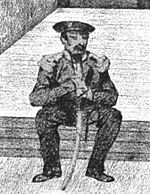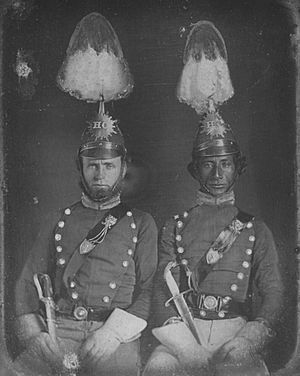Francisco de Paula Marín facts for kids
Quick facts for kids
Don Francisco de Paula Marín Grassi
|
|
|---|---|
 |
|
| Born |
Francisco de Paula Marín y Grassi
November 25, 1774 Jerez de la Frontera, Spain
|
| Died | October 30, 1837 (aged 62) |
| Nationality | Spanish |
| Other names | Marini, Manini |
| Known for | Horticulture |
| Spouse(s) | At least three |
| Children | Many |
| Parent(s) | Juan Marín María Grassi |
| Signature | |
Don Francisco de Paula Marín (1774–1837) was a Spanish explorer and gardener. He became very important in the early Kingdom of Hawaii. People often called him Manini or Marini. He was a trusted friend and helper to Hawaiian King Kamehameha I. Marín was skilled in many areas. He even acted as a doctor, though he likely had no formal training. He is famous for bringing many new plants and foods to Hawaii.
Contents
About Don Francisco de Paula Marín
Early Life and Arrival in Hawaii
Francisco de Paula Marín was probably born on November 25, 1774. His hometown was Jerez de la Frontera in Spain. This area is close to Cadiz. His parents were Juan Marín and María Grassi.
He likely worked as a pilot on a ship. This ship was part of the Malaspina Expedition. At some point, he left the Spanish ship. He then joined an American ship called the Lady Washington.
Marín arrived in the Hawaiian Islands around 1793 or 1794.
Helping King Kamehameha
Marín became an interpreter for King Kamehameha I. He also advised the King on how to use Western military weapons. This was during the time Kamehameha I was taking over Oʻahu island. This happened during the Battle of Nu'uanu.
Because of his help, King Kamehameha I gave Marín land. This land was in what is now Honolulu. Marín also traveled off the islands at least one more time. In 1804, he worked as a pilot on the ship Hazard. He helped Captain James Rowan talk to Native Americans in the Pacific Northwest.
Marín stayed on good terms with the Spanish in Alta California. He was also friendly with other visitors. These included French navigator Louis de Freycinet in 1819.
Growing New Plants and Foods
Marín loved to experiment with new plants. He often asked for seeds, plants, and animals from visitors. Then he would try growing them in Hawaii.
In 1815, he started Hawaii's first grape vineyard. He made the first wine and brandy there. He also made rum from sugarcane.
Marín grew Hawaii's first pineapple crop in 1813. He is also known for growing the first cotton, mango, and orange plants. He also raised some of the first horses and cattle. While some people had small gardens, Marín ran the first large-scale farm in the Western style.
His home became a place where visiting merchants could stay. He rented rooms and served meals to them.
Marín could speak several languages. This made him an unofficial diplomat for Honolulu. He also worked as an accountant and tax collector. He sold his farm products to ships that needed supplies.
In April 1819, he helped care for the sick King Kamehameha. He stayed with the King until he passed away on May 8. The new King, Kamehameha II, liked Marín's refreshments. On December 10, 1819, Kamehameha II made Marín a captain in the Hawaiian Army.
His Family and Connections
Marín had a large family with many children. One of his daughters married Antonio Ferreira. He was a stonemason who built one of Honolulu's first stone houses in 1810. Another daughter, Cruz Marín, married English sea captain Joseph Maughan.
His sons, Nicolas and Paul F. Marin, helped build early commercial areas near the waterfront. His youngest daughter, Antoinette Francesa Manini (1832–1905), married businessman Lyman Swan in 1851. Her family later moved to Santa Cruz, California.
Marín supported the Roman Catholic Church. When the first priests arrived, his growing family made up a big part of the church community.
He also helped as an interpreter when the first Christian missionaries arrived in 1820. When Richard Charlton, the first British trade representative, arrived, Marín helped him.
In 1825, the ship HMS Blonde arrived with the bodies of Kamehameha II and his queen. They had died in London. This ship also brought more plants for Marín. These included some of the first coffee trees. Many of these plants grew well on Marín's farm.
Lasting Impact
Don Francisco de Paula Marín passed away in Honolulu on October 30, 1837. Later, a historian named Robert Crichton Wyllie found Marín's diary. Wyllie said that much of Hawaii's wealth came from the plants and seeds Marín brought. He believed Marín was one of the most important people for the Hawaiian people.
Marin Street near the Honolulu Harbor is named after him. A tall apartment building called Marin Tower was built in 1994. It stands where his house used to be. A plaque and a sculpture mark the spot. Vineyard Street and Boulevard are also named for his famous vineyard.
See also
 In Spanish: Francisco de Paula Marín Grassi para niños
In Spanish: Francisco de Paula Marín Grassi para niños



